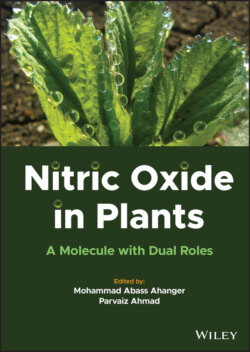Читать книгу Nitric Oxide in Plants - Группа авторов - Страница 30
2.5.3 Ultraviolet Radiation
ОглавлениеSunlight is the principal source of energy for plants, and a portion of this energy exists in the form of ultraviolet (UV) radiation. It is typically partitioned into three categories: (i) UV-A (315–400 nm), (ii) UV-B (280–315 nm), and (iii) UV-C (200–280 nm). It is well known that the atmospheric gases completely absorb UV-C radiation, while UV-B rays are moderately absorbed by tropospheric ozone, and only a trivial fraction is transferred to the surface, and UV-A is scarcely absorbed by the ozone. Since the destruction of the ozone layer, the levels of UV-B radiation rise on the Earth’s surface. UV-B has high energy and induces production of ROS that employ harmful morphological and molecular changes in plants (Simontacchi et al. 2015). Chloroplasts are highly affected by UV-B radiation and the light-induced impairment is directed primarily to photosystem II (PSII), with the inhibition of the respiratory chain and oxidative damage to the D1 protein. UV-B treatment increased leakage of ions, hydrogen peroxide levels, and oxidation of thylakoid membrane protein in bean (Phaseolus vulgaris) leaves. It was also observed that the proficiency of PSII photochemistry (F v/F m) and the considerable production of PSII was decreased under UV radiation. But after exposure to NO, carbonyl groups of thylakoid membrane and levels of H2O2 were decreased. Thus, NO could exert a protective role against protein oxidation under stress conditions as was previously reported regarding lipid oxidation (Vanhaelewyn et al. 2016; Mannucci et al. 2020).
UV-B adversely affects the chloroplast and mesophyll cells of a plant. It has been reported that UV-B increases the level of plant hormone ABA, activates the NADPH oxidase, and generates H2O2. Pretreatment with apocynin (an inhibitor of NADPH oxidase), minimizes the UV-B-induced oxidative damage by reducing the breakdown of chlorophyll (Tewari et al. 2013; Bajguz 2014).
Ozone is formed by a photochemical reaction in NOx and volatile organic compounds (VOCs) and enters the plants through stomata where it accumulates in parenchyma tissues. As a pollutant, it affects the plant by generating oxidative stress via releasing ROS, e.g. superoxide O2−, singlet oxygen, hydroxyl radicals, and hydrogen peroxide in the plant cells. This oxidative stress can further damage the DNA, carbohydrate, lipids, and proteins (Vaultier and Jolivet 2015; Li et al. 2018). The contribution of NO in response to UV-B rays acts through ABA-mediated pathways (Xu et al. 2012). It has been proposed that in plant cells, UV-B radiation stress leads to an increase in ABA levels, which stimulates an increase in cytosolic Ca2+ concentration that ultimately starts NO production via NOS and/or NOS-like activities. This increase in NO production increase a plant’s tolerance for higher doses of UV-B indirectly by protecting cell redox homeostasis from uncontrolled generation of ROS and associated deleterious effects provoked by UV-B radiation.
